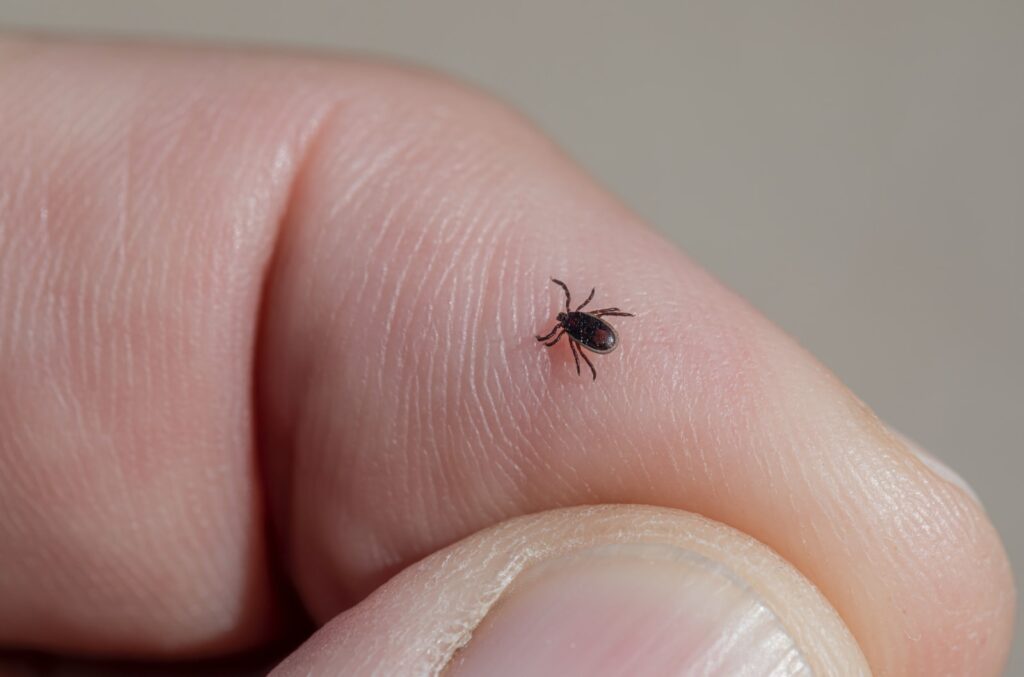Page Menu
Tickborne diseases are caused by bacteria and parasites that are transferred to humans through the bites of infected ticks. Symptoms can vary depending on the disease, but most commonly include fever, rash, and joint pain. Some tickborne diseases, such as Lyme disease, can be serious and even life-threatening.
Key Concepts and Top Takeaways
– Recognize symptoms: Look for fever, chills, fatigue, and rash after potential tick exposure.
– Check for ticks: Inspect your body and clothing after outdoor activities in wooded areas.
– Remove ticks promptly: Use fine-tipped tweezers to grasp the tick close to the skin and pull upward steadily.
– Monitor for changes: Keep an eye on any unusual symptoms following a tick bite for several weeks.
– Wear protective clothing: Use long sleeves, pants, and light-colored clothing when hiking or camping.
– Use insect repellent: Apply EPA-approved repellents containing DEET on exposed skin and clothes.
– Avoid tall grass and brush: Stick to the center of trails when walking through wooded areas.
– Educate yourself about local ticks: Know which ticks are prevalent in your area and their associated diseases.
– Vaccinate if necessary: Consult with a healthcare provider about vaccines available for certain tick-borne diseases.
– Seek medical attention early: Contact a doctor if you suspect a tick-borne illness or experience severe symptoms.
Please Note: This post may contain affiliate links. If you click one of them, we may receive a commission at no extra cost to you. As an Amazon Associate, I earn from qualifying purchases.

Tickborne diseases are a serious problem in the United States. They can be caused by more than 30 different pathogens and can result in serious health complications. Tickborne diseases are spread through the bite of a tick. There is no one vaccine available to prevent these diseases, so prevention is important. Tickborne diseases can be contracted through hiking, camping, fishing, gardening, playing in the park, or walking in grassy areas.
Tickborne diseases are caused by bacteria, viruses or protozoa that can be transferred to humans through the bite of an infected animal, such as a tick. Symptoms of tickborne diseases can vary, but they often include fever, rash, headache and muscle aches. Some tickborne diseases, like Lyme disease, can cause serious complications including arthritis and seizures. There is no one vaccine available to protect against all tickborne diseases, so it is important to know which ones you are at risk for and take precautions to avoid being bitten by ticks.
Symptoms of Tickborne Disease
The symptoms of tickborne diseases vary depending on the specific infection but can generally be summarized under these headings: fever, rash, joint pain, headaches, muscle aches, shortness of breath, and swollen lymph nodes. Many people with Lyme disease don't experience any symptoms at all, while others may have only a few minor ones. Tickborne encephalitis is the most serious form of tick-borne illness and can cause seizures, coma and even death.
Fever is often one of the first signs that a person may have contracted tick-borne disease. However, not all people who develop fever from a tick-borne illness will have evidence of a tick bite on their skin. In fact, it is quite common for people to have no recollection of being bitten by a tick or to have only mild symptoms from the bite.
The rash is a common symptom of Tickborne Disease. It can be a sign that you have the disease, and it can make it difficult to tell if you have contracted it. The rash can also be a sign that the tick has infected you and may lead to more serious symptoms. If you experience a rash, be sure to get checked out by your doctor.
Joint pain is one of the most common symptoms of tickborne diseases. These infections can cause inflammation and swelling in the joints, which can make it difficult to move around or even walk. In some cases, joint pain may be the only sign that someone is infected with a tick-borne disease.
Headaches are one of the most common symptoms reported by patients with Tickborne Diseases. In fact, they are the number one symptom reported by people who get infected with a Tick-borne Disease.
There are several types of headaches that can be caused by Tickborne Diseases, including: Cluster headache, migraine, and tension-type headaches. Many people who have these types of headaches also report feeling a lot of pain in their temples or around their eyes.
Muscle aches are a common symptom of Tickborne diseases. In particular, Lyme disease is known to cause severe muscle aches. Other symptoms that may occur include fever, chills, headaches, and fatigue. While Tickborne diseases are serious infections that should be treated as soon as possible, Muscle aches can often be treated with rest and ibuprofen.
Shortness of breath is a common symptom of Tickborne Disease. The most common type of Tickborne Disease is Lyme Disease, which is caused by the bacteria Borrelia burgdorferi. Other types of Tickborne Diseases include Rocky Mountain Spotted Fever, Eastern equine encephalitis, and West Nile Virus. All of these diseases can cause shortness of breath, as well as other signs and symptoms such as fever, headache, muscle aches, and fatigue. If you experience any of these symptoms after being in contact with a Tick or any other animal that carries a Tick-borne Disease, it is important to seek medical help immediately.
Swollen lymph nodes are one of the most common symptoms of Tickborne Disease. These nodes can be a sign that you are infected with the bacteria that causes Lyme Disease or another Tick-borne Pathogen. The lymph nodes may also be enlarged due to other factors, such as a viral illness or cancer. Swelling in the neck, armpit, and groin can be an early indication of Lyme Disease.
Causes of Tickborne Disease
Lyme disease is caused by a spirochete bacterium called Borrelia burgdorferi. This bacterium is found in the environment, but it can also be transmitted through tick bites. Other Tick-borne Pathogens can cause swollen lymph nodes as well, including Rickettsia rickettsii (responsible for Rocky Mountain Spotted Fever) and Babesia microti (a parasite that causes babesiosis).
Tickborne diseases are caused by bacteria, viruses, or protozoa that can be transmitted to humans through the bites of infected animals, such as ticks.
Burgdorferi is a bacterium that causes Lyme disease. Lyme disease is a vector-borne infection that can be caused by the bite of any type of tick. The most common places to get Lyme disease are in the northeastern and midwestern United States, but it has also been reported in other parts of the world. Burgdorferi can be found in several different animal species, including deer, moose, rabbits, and blacklegged ticks (Ixodes scapularis).
Lyme disease is caused by the bacterium Borrelia burgdorferi. It is transmitted to humans through the bite of infected ticks. The most common place to get Lyme disease is in the northeastern and midwestern United States, but it has also been reported in other parts of the world.
Rickettsia rickettsii is a bacterium that can cause diseases such as Rocky Mountain spotted fever (RMSF), babesiosis, and ehrlichiosis. RMSF is the most commonly reported Rickettsia rickettsii disease in the United States, accounting for around 60% of all cases. About 80% of people who contracted RMSF did not know they were infected. RMSF is most commonly spread through contact with the saliva or blood of an infected animal, such as a dog, cat, or deer. Babesiosis is caused by the parasites Babesia microti and Babesia indica and can lead to serious health problems including fever, chills, and swollen lymph nodes.
Babesia microti is a type of bacteria that can cause tickborne disease. Babesia microti is found in the blood of both animals and humans. Babesia microti is most commonly found in the southeast United States, but it can also be found in other parts of the world. Tickborne diseases are caused by parasites that are transferred to people through ticks. Most tickborne diseases are mild, but they can be serious if not treated quickly. The most common tickborne diseases in the United States are Lyme disease and Rocky Mountain spotted fever.
Risk Factors for Tickborne Disease
There are many risk factors for Tickborne Disease. Some of the most common include being in a tick-infested area, having a tick bite, traveling in an area where there is a high concentration of ticks, being elderly, and having a weakened immune system. Other risk factors include living in or visiting areas with high humidity levels (which can increase the likelihood of getting bitten by a tick), being exposed to rodents or wild animals that may carry Lyme Disease or Ehrlichiosis and failing to properly clean up after yourself when outdoors.
Tickborne disease is a serious public health concern in the United States. Tick-infested areas are a risk factor for contracting these diseases. Tickborne diseases can be debilitating, and even fatal, if not treated promptly. Persons who live or work in tick-infested areas should take precautions to avoid exposure to ticks and other vectors that can spread the parasites.
Tickborne diseases are a serious public health concern in the United States. In 2017, Tickborne Disease Prevention and Control reported 7,641 cases of Lyme disease, 3,326 cases of Rocky Mountain Spotted Fever, and 1,564 cases of Powassan virus.1 In addition to these diseases, there are dozens of other tick-transmitted illnesses that can cause significant health problems.
Having a tick bite is a risk factor for Tickborne Disease. Tick bites can transmit several different diseases, including Lyme disease, Rocky Mountain spotted fever (RMSF), Powassan virus (POWV), and Babesiosis. Ticks can also spread other pathogens such as Ehrlichiosis and Anaplasmosis. A tick bite should always be treated as an infection until confirmed otherwise by a doctor.
Having a weakened immune system is one of the leading risk factors for Tickborne Disease. A weakened immune system can make you more susceptible to infections, including those caused by ticks. Tickborne diseases are some of the most serious and deadly diseases out there, and they’re especially dangerous for children and the elderly. If you’re at high risk for these diseases, it’s important to take steps to protect yourself from tick bites.
Being elderly is a risk factor for Tickborne Disease. Tickborne diseases are infections caused by ticks. These infections can be serious and even deadly, particularly in older people. Tickborne Diseases include Lyme Disease, Rocky Mountain Spotted Fever, Eastern Equine Encephalitis, Dogwood Blight and Babesiosis. It is important to be aware of the risks associated with being elderly and to take appropriate precautions to protect yourself from Tickborne Disease. Here are some tips:
– Check your skin for ticks after spending time outdoors or anytime you are in tick-infested areas. Ticks can attach themselves to your skin very quickly.
– If you find a tick on yourself, remove it as soon as possible using a tweezers or fingernail clippers. Don’t squeeze the tick – this may kill it and make the infection worse.
There are many risk factors for tickborne disease. Some of these include being outdoors in a wooded or grassy area, having pets that spend time outdoors, and being in an area where ticks are known to live. There are many ways to protect yourself from tick bites, including using insect repellent, wearing long pants and sleeves, and checking your body for ticks after being outside. If you do find a tick on your body, remove it as quickly as possible using tweezers.
Complications From Tickborne Disease
Complications from Tickborne Diseases can occur in a number of ways. Symptoms of many tick-borne diseases include fever, rash, joint pain, and headaches. Complications can also include seizures, coma, and even death. Some of the most common tick-borne diseases are Lyme disease, Rocky Mountain spotted fever, tularemia, and babesiosis. Each of these diseases can be serious and lead to long-term complications if not treated promptly.
Lyme disease is the most common tick-borne disease in the United States and is caused by the Borrelia burgdorferi bacterium. symptoms typically develop after exposure to ticks infected with this bacterium. Treatment for Lyme disease typically includes antibiotics taken for two weeks or longer.
Ehrlichiosis: Ehrlichiosis is a dangerous tick-borne disease that can affect humans and other animals. It is most commonly spread through the bite of an infected blacklegged tick. Symptoms include fever, chills, headache, and muscle aches. In severe cases, ehrlichiosis can lead to organ failure and death.
Seizures are a common complication from tickborne diseases. Ticks can spread diseases such as Lyme disease, Ehrlichiosis, Anaplasma and babesiosis. All of these diseases can cause seizures. Tickborne encephalitis (TBE) is the most common form of tick-borne encephalitis. It is caused by the bite of an infected blacklegged tick. Symptoms include fever, headache, neck stiffness, nausea and vomiting, and a loss of appetite.
Seizures can occur at any stage of the illness and may be preceded by neurological symptoms such as confusion or memory loss. If left untreated, TBE can lead to coma and death. Early diagnosis and treatment with antibiotics is critical for preventing serious complications from this infection.
Coma is a common complication from Tickborne Diseases. In the United States, Lyme Disease (Borrelia burgdorferi) is the most commonly reported Tickborne Disease, followed by Ehrlichiosis/ Anaplasmosis.
The Centers for Disease Control and Prevention (CDC) estimates that between 2008 and 2012, there were 36,644 cases of Lyme disease reported in the U.S., including 333 deaths. The incidence of Lyme disease has been increasing since its recognition in 1975, but has leveled off in recent years.
Treatment for Tickborne Disease
Most people who contract Lyme disease don't even know it. The spirochete bacterium that causes Lyme disease is transmitted to humans through the bite of a tick. Once contracted, Lyme disease can cause serious health problems, including arthritis and heart trouble. Treatment for Lyme disease typically includes antibiotics and pain relief. There is no vaccine or cure for Lyme disease, but there are treatments available to help manage symptoms.
There is no one cure for tickborne diseases, but there are a variety of treatments that can be used. The most common treatment is antibiotics. Other treatments include antiviral medications, anti-parasitic medications, and antiparasitic drugs. Vaccines are also available for some tickborne diseases, but they are not always effective. Treatment depends on the type of tick that has bitten someone and the person's history and symptoms.
Antibiotics are one type of treatment that can be used to treat tickborne diseases. These diseases are caused by infection with the bacteria Borrelia burgdorferi, which is found in ticks. The most common tickborne disease is Lyme disease, which is caused by B. burgdorferi. Other tickborne diseases include anaplasmosis, babesiosis, and ehrlichiosis.
Antibiotics can help to kill the bacteria that cause tickborne diseases. They can also help to reduce the amount of damage that the bacteria can cause inside the body. Some antibiotics are also able to stop the spread of the infection from person to person.
There are a few different types of antibiotics that can be used to treat tickborne diseases. Different antibiotics work better for different types of infections.
Antiviral medications are an effective treatment for Tickborne Disease. These medications work by stopping the virus from replicating and causing symptoms. There are several different antiviral medications available, each with its own specific benefits and limitations. Treatment varies depending on the type of Tickborne Disease and the severity of symptoms. However, antiviral medication therapy is typically very successful in treating these diseases.
Tickborne diseases are a major global health problem, accounting for over 500,000 cases annually. Many tickborne diseases can be treated with anti-parasitic medications. These medications work by killing or inhibiting the growth of the parasites that cause the disease. Anti-parasitic medications are relatively safe and are currently the most effective treatment for tickborne diseases.
Common Questions About Tickborne Disease
How many tickborne illnesses are there? There are over 30 tickborne diseases in the United States, with more being discovered all the time. This means that there is always a risk of getting sick from a tickborne illness. Tickborne illnesses are caused by bacteria, viruses, or parasites that are transmitted through the bites of ticks. The most common tickborne illnesses are Lyme disease, Rocky Mountain spotted fever, and babesiosis. Each of these diseases can be serious and even fatal if not treated properly. To minimize your risk of getting sick from a tickborne illness, be sure to check for ticks regularly and protect yourself and your family from exposure to ticks.
What are the 3 stages of Lyme disease? Lyme disease is a serious infection caused by the bacterium Borrelia burgdorferi. The three stages of Lyme disease are early, intermediate, and late. In early-stage Lyme disease, symptoms may include fever, headache, muscle aches, and a general feeling of being unwell. In the intermediate stage, symptoms may include more serious conditions such as arthritis or cardiac problems. Finally, in the late stage of Lyme disease, patients can experience death if not treated. The best way to prevent Lyme disease is to avoid exposure to ticks and to get treatment if you become infected.
What is human granulocytic anaplasmosis? Human granulocytic anaplasmosis is a rare blood infection caused by the bacterium Anaplasma phagocytophilum. Symptoms of human granulocytic anaplasmosis can include fever, chills, and neck stiffness. The disease is most often spread through the respiratory tract but can also be passed through contact with saliva or blood. Treatment typically includes antibiotics and supportive care. Human granulocytic anaplasmosis is believed to be inherited in an autosomal recessive manner.
Is Ehrlichia serious? Yes, it can be deadly if not treated quickly. Ehrlichia can cause fever, vomiting, and diarrhea. In some cases, the disease can lead to meningitis or encephalitis (inflammation of the brain), and even death. If you think you may have contracted Ehrlichia, contact your doctor immediately.
What is the most common tick-borne disease? The most common tick-borne disease is Lyme disease. It is caused by the bacterium Borrelia burgdorferi and can be transmitted to humans through the bite of a black-legged tick. Other diseases that can be transmitted through ticks include anaplasmosis, babesiosis, ehrlichiosis, andtick-borne encephalitis.
How bad is Lyme disease? Lyme disease is a bacterial infection that can be debilitating, and in some cases even life-threatening. Lyme disease is estimated to affect 300,000 Americans each year and can cause significant symptoms, including fever, headache, neck stiffness, and muscle pain.
Although Lyme disease is treatable with antibiotics, many people do not receive treatment due to its vague symptoms. Untreated Lyme disease can lead to permanent damage to the brain and nervous system. In severe cases, patients may require long-term antibiotic therapy or surgery to remove the infected area of their body.
Lyme disease is considered relatively mild when compared with other serious bacterial infections, such as tuberculosis (TB). However, because Lyme disease often goes undiagnosed and untreated for long periods of time, it can become much more serious in some cases.
How long can you live with Lyme disease? Lyme disease is a debilitating and potentially fatal illness caused by the bacterium Borrelia burgdorferi. The disease can affect any part of the body, but is most common in the joints, muscles, and nervous system. Lyme disease can be treated with antibiotics, but patients may experience long-term symptoms such as fatigue, inflammation, and arthritis. Some people who contract Lyme disease experience a brief period of improvement followed by a relapse. The average lifespan for someone who contracts Lyme disease is around six months, but some people have survived for years.
Can Lyme disease go away on its own? Lyme disease is a bacterial infection that can cause fever, headache, neck stiffness and a rash. Although it can be treated with antibiotics, many people experience long-term symptoms, such as fatigue and arthritis. Some people believe that Lyme disease can go away on its own, but research suggests that this is not always the case. In some cases, antibiotics may be necessary to treat the infection and improve symptoms.
What does anaplasmosis do to your body? Anaplasmosis is a lung infection caused by the Anaplasma species of bacteria. The most common symptom of anaplasmosis is fever, followed by chest pain, shortness of breath, and coughing. In severe cases, anaplasmosis can lead to pneumonia, which can be fatal. Anaplasmosis is most commonly contracted from exposure to the air or water droplets containing the bacteria. The most common way to get infected with anaplasmosis is through contact with infected animals (such as cattle), or through contact with contaminated soil.
In conclusion, tickborne diseases are serious illnesses that can cause a variety of symptoms. They are caused by bacteria, viruses, or parasites that are transmitted by ticks. The risk factors for these diseases include being outdoors in tick-infested areas, having pets that roam in the woods, and working or playing in tick-infested areas. Some of the complications of tickborne diseases include meningitis, encephalitis, and heart failure.

Kevin Collier is a seasoned health writer at Otchut.com, specializing in over-the-counter medicines, common medical ailments, and general health topics. With a background in healthcare and a passion for making medical information accessible, Kevin aims to empower readers with knowledge to make informed health decisions. When he's not writing, he enjoys researching the latest in health trends and advocating for wellness in his community.






